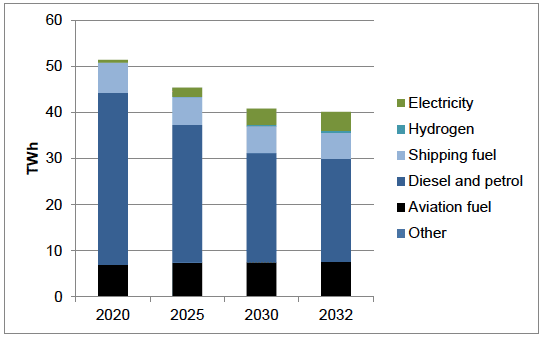Climate Change Plan: third report on proposals and policies 2018-2032 – technical annex
This annex provides an overview of the analysis underpinning the Climate Change Plan
Transport
Sector Overview:
The Transport sector is incorporated into TIMES in the same way as other energy sectors, with a set of final energy demands that must be met using a range of technologies (diesel, electric and hybrid vehicles amongst others) with varying efficiencies, costs and lifetimes. These technologies each consume one or more inputs, such as electricity or petrol, which are manufactured within the rest of the system or can be imported. As a result, demands in the transport sector compete for resources with other sectors.
The emission projections and fuel shares for Transport in the draft CCP were based on data provided by Transport Scotland and sourced from research by Element Energy, providing a detailed representation of the transport sector in Scotland. These were incorporated into TIMES by aligning the emissions and fuel shares in TIMES to those in Element Energy. The original projections and fuel shares have now been updated following the Programme for Government announcement on phasing out the need to buy petrol and diesel engine cars and vans by 2032, and have been coded into TIMES. Changes in the transport fuel shares incorporated in TIMES will ripple through the rest of the system, as Transport supply chains are fully incorporated into the model.
In future, we will aim to increasingly align underlying parameters for the sectors, such as efficiencies and costs by mode, with those supporting Element Energy, which will allow us to produce greater granularity of results in TIMES.
Data Inputs:
During the course of developing the Plan, it became clear that Transport Scotland's commissioned research, undertaken by Element Energy, offered additional detail over the core TIMES Transport module and, as such, it was used to develop the Transport fuel shares by subsector and emissions envelopes. Element Energy's work included the construction of a detailed Scottish vehicle database, including number, age and turnover of the Scottish vehicle parc, a peer review of their database of technology costs across transport modes (used to refine their cost models for alternative fuels and technologies) and finally, used their consumer demand model to develop realistic scenarios for the take up of alternatively fuelled vehicles, particularly cars. Finally, demands for air travel and shipping, including both domestic and international, are incorporated into the overall transport demand and energy requirements.
Data for the Transport sector has been sourced from UK TIMES, the Transport Model for Scotland, Scottish Transport Statistics, the Scottish Government's Energy in Scotland publication, as well as publications from BEIS and Ricardo- AEA.
Additional constraints since the Draft Plan:
Fuel shares and emissions envelopes resulting from the Element Energy work have now been adjusted for the Programme for Government announcement and coded into TIMES so that their wider impact on the energy system can be considered.
Results:
The figure below shows the TWh breakdown of fuel consumption in the Transport sector. By 2032, the share of petrol and diesel falls by around 17 percentage points over 2020 levels. At the same time, there is a general increase in all other fuels, in particular electricity, which increases by nearly 9 percentage points over the period, reaching around 10% in 2032.
Figure 16: Fuel Mix for Transport ( TWh), TIMES results based on Element Energy fuel shares, adjusted where appropriate to take into account the Programme for Government announcement

Overall, energy used to power transport falls by over a fifth between 2020 and 2032, as a result of an increase in the efficiency of future transport and the move towards electric cars and vans, which are significantly more energy efficient than existing engines.
Contact
There is a problem
Thanks for your feedback